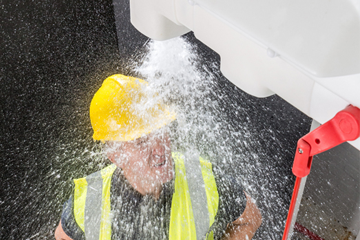Enquiry List () (0)
- 19 Aug 2020

Diminishing the risks at data storage centres

Data centre sites store computing and networking equipment for the purpose of collecting, storing, processing, distributing or allowing access to large amounts of data. Used by the likes of Microsoft and Facebook, the size of these sites range from just one small room to gargantuan campuses stretching to 7.2 million square feet at their largest. There are over 200 of these data centres in the UK alone, with more appearing every year to meet increasing demand.
In the early days of primitive room-sized giant computers, a data centre might have had one supercomputer. As equipment evolved and became much smaller and cheaper, data processing needs started to increase with multiple servers networked together to increase processing power. Large numbers of these clustered servers can be housed in a room, a building or groups of buildings. A modern data centre is likely to have thousands of small servers running 24/7.
‘Lights-out’ centres, where the need for direct access by personnel has been all but eliminated, are commonplace. However, there are still a large number of data centres worldwide where employees are frequently onsite and interfacing with equipment. The cooling and cleaning processes, along with the back-up power required for the sites can pose risks to workers that require the availability of safety showers and/or eye/face wash equipment.
Hazard considerations
Lithium batteries or lead-acid batteries are often used as a backup source, both of which create potential hazards. With lead-acid batteries, if there is a leak, direct contact of internal electrolyte liquid with the skin can cause irritation or damaging burns. Lithium batteries are still considered a newer form of back-up power for data centres and are therefore largely untested in this field, but they do run the risk of overheating and setting on fire.
Every data centre needs a system for cooling the servers, as they can easily overheat. Some refrigerants used, such as water, are not harmful if splashed onto skin but others, such as ammonia, can be extremely dangerous and require immediate flushing at a set temperature to avoid burns.
Safety shower solutions 
- Cubicle showers with in-built sumps are ideal ensure that any spray and contaminated water from a safety shower is contained and does not touch any nearby electrical equipment. Designed for areas where space is at a premium, designating a dedicated safety shower space, these units are perfect for the limited space available within a data centre.
- Anhydrous ammonia used in refrigeration, requires safety showers to deliver a large amount of water for at least 15 minutes, at a temperature between 25C-30C. Temperature Controlled Safety Showers maintains the water within this range and can also be used to supply heated water to other emergency safety showers in the local vicinity.
- Emergency tank showers are often simplest and most comprehensive way to meet ANSI standards with the ability to provide tepid water in most environments. Additionally, these units are designed for areas where there is no mains supply or where the water pressure is inadequate.
To ensure spills are flushed from the skin and eyes quickly to best minimise injury, emergency safety showers must be located within 10 seconds of the hazard. However, if a chemical is particularly dangerous, the equipment should be placed immediately adjacent to the hazard.
Emergency safety showers and eye/face wash equipment must also be situated in a prominent position, clearly visible, well-lit and free from any obstructions.
For further information on location, use and testing of emergency safety showers, refer to our EN and ANSI standards summary here.
For advice on the most suitable solution for your application or to request a quote, contact us today.












